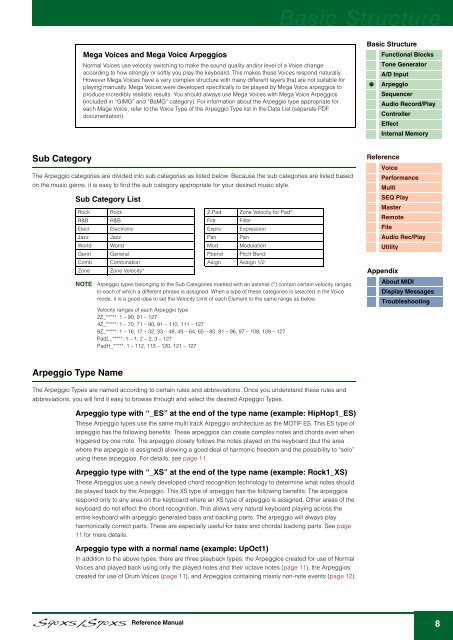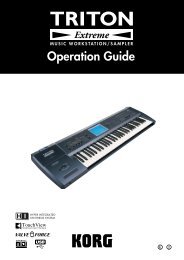S90 XS/S70 XS Reference Manual - zZounds.com
S90 XS/S70 XS Reference Manual - zZounds.com
S90 XS/S70 XS Reference Manual - zZounds.com
Create successful ePaper yourself
Turn your PDF publications into a flip-book with our unique Google optimized e-Paper software.
Sub Category<br />
The Arpeggio categories are divided into sub categories as listed below. Because the sub categories are listed based<br />
on the music genre, it is easy to find the sub category appropriate for your desired music style.<br />
Sub Category List<br />
NOTE Arpeggio types belonging to the Sub Categories marked with an asterisk (*) contain certain velocity ranges,<br />
to each of which a different phrase is assigned. When a type of these categories is selected in the Voice<br />
mode, it is a good idea to set the Velocity Limit of each Element to the same range as below.<br />
Arpeggio Type Name<br />
Mega Voices and Mega Voice Arpeggios<br />
Normal Voices use velocity switching to make the sound quality and/or level of a Voice change<br />
according to how strongly or softly you play the keyboard. This makes these Voices respond naturally.<br />
However Mega Voices have a very <strong>com</strong>plex structure with many different layers that are not suitable for<br />
playing manually. Mega Voices were developed specifically to be played by Mega Voice arpeggios to<br />
produce incredibly realistic results. You should always use Mega Voices with Mega Voice Arpeggios<br />
(included in “GtMG” and “BaMG” category). For information about the Arpeggio type appropriate for<br />
each Mage Voice, refer to the Voice Type of the Arpeggio Type list in the Data List (separate PDF<br />
documentation).<br />
Rock Rock Z.Pad Zone Velocity for Pad*<br />
R&B R&B Filtr Filter<br />
Elect Electronic Exprs Expression<br />
Jazz Jazz Pan Pan<br />
World World Mod Modulation<br />
Genrl General Pbend Pitch Bend<br />
Comb Combination Asign Assign 1/2<br />
Zone Zone Velocity*<br />
Velocity ranges of each Arpeggio type<br />
2Z_*****: 1 – 90, 91 – 127<br />
4Z_*****: 1 – 70, 71 – 90, 91 – 110, 111 – 127<br />
8Z_*****: 1 – 16, 17 – 32, 33 – 48, 49 – 64, 65 – 80, 81 – 96, 97 – 108, 109 – 127<br />
PadL_*****: 1 – 1, 2 – 2, 3 – 127<br />
PadH_*****: 1 – 112, 113 – 120, 121 – 127<br />
The Arpeggio Types are named according to certain rules and abbreviations. Once you understand these rules and<br />
abbreviations, you will find it easy to browse through and select the desired Arpeggio Types.<br />
Arpeggio type with “_ES” at the end of the type name (example: HipHop1_ES)<br />
These Arpeggio types use the same multi track Arpeggio architecture as the MOTIF ES. This ES type of<br />
arpeggio has the following benefits: These arpeggios can create <strong>com</strong>plex notes and chords even when<br />
triggered by one note. The arpeggio closely follows the notes played on the keyboard (but the area<br />
where the arpeggio is assigned) allowing a good deal of harmonic freedom and the possibility to “solo”<br />
using these arpeggios. For details, see page 11.<br />
Arpeggio type with “_<strong>XS</strong>” at the end of the type name (example: Rock1_<strong>XS</strong>)<br />
These Arpeggios use a newly developed chord recognition technology to determine what notes should<br />
be played back by the Arpeggio. This <strong>XS</strong> type of arpeggio has the following benefits: The arpeggios<br />
respond only to any area on the keyboard where an <strong>XS</strong> type of arpeggio is assigned. Other areas of the<br />
keyboard do not effect the chord recognition. This allows very natural keyboard playing across the<br />
entire keyboard with arpeggio generated bass and backing parts. The arpeggio will always play<br />
harmonically correct parts. These are especially useful for bass and chordal backing parts. See page<br />
11 for more details.<br />
Arpeggio type with a normal name (example: UpOct1)<br />
In addition to the above types, there are three playback types: the Arpeggios created for use of Normal<br />
Voices and played back using only the played notes and their octave notes (page 11), the Arpeggios<br />
created for use of Drum Voices (page 11), and Arpeggios containing mainly non-note events (page 12).<br />
<strong>Reference</strong> <strong>Manual</strong><br />
Basic Structure<br />
Basic Structure<br />
Functional Blocks<br />
Tone Generator<br />
A/D Input<br />
Arpeggio<br />
Sequencer<br />
Audio Record/Play<br />
Controller<br />
Effect<br />
Internal Memory<br />
<strong>Reference</strong><br />
Voice<br />
Performance<br />
Multi<br />
SEQ Play<br />
Master<br />
Remote<br />
File<br />
Audio Rec/Play<br />
Utility<br />
Appendix<br />
About MIDI<br />
Display Messages<br />
Troubleshooting<br />
8
















